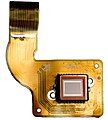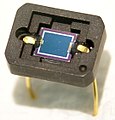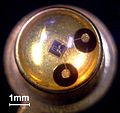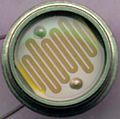Photodetector
· 
Photomultiplier (front view)
· 
Photomultiplier (side view)
· 
CCD sensor
· 
Photodiode
· 
Phototransistor
· 
Photoconductive cell
Photodetector, also light sensor or optical detector, optoelectronic sensor, are electronic components which convert light into an electrical signal using the photoelectric effect or show an electrical resistance dependent on the incident radiation. However, the term is also used to refer to applications that have integrated such a radiation-measuring component. In optoelectronics, the term light refers not only to visible light, but also to invisible infrared light and ultraviolet radiation.
An optoelectronic sensor can be a signal acquisition device (for example, an exposure meter) or be integrated into an imaging measurement process in which the light-receiving surface is divided into individual areas (pixels) so that - in conjunction with a lens and camera electronics - an electrical image can be generated. For robotics and medical applications, developments are already underway in the direction of complex visual apparatuses using cameras and their signal processing.
Photodetectors that use the external photoelectric effect include:
- Photocells
- Photomultiplier (fast, smallest amounts of light down to single photons)
- Microchannel plate photomultiplier (same principle as the photomultiplier, but with even better time resolution)
Photodetectors that use the internal photoelectric effect include:
See also
- Radiation detector for other electromagnetic radiation
- Sensors according to measuring principle#Optoelectronic sensors (optical sensors)
Questions and Answers
Q: What is a photocell?
A: A photocell is an electronic component that changes its electrical conductivity when light shines on it.
Q: What happens to electricity flow in a photocell when light shines on it?
A: When light shines on a photocell, more electricity flows through it.
Q: What material can be used to make photocells?
A: Selenium can be used to make photocells, but some other chemicals can also be used.
Q: What are semiconductors used for in photocells?
A: Semiconductors are used to make photocells. When light shines into the photocell, it "loosens" the electrons, allowing them to flow and make an electrical current.
Q: What is the function of the reddish part of a photocell?
A: The electricity flows through the reddish part of the photocell.
Q: Does electricity flow through a photocell when it is dark?
A: Almost no electricity flows through a photocell when it is dark.
Q: What is another name for a photocell?
A: Another name for a photocell is photoresistor.
Search within the encyclopedia